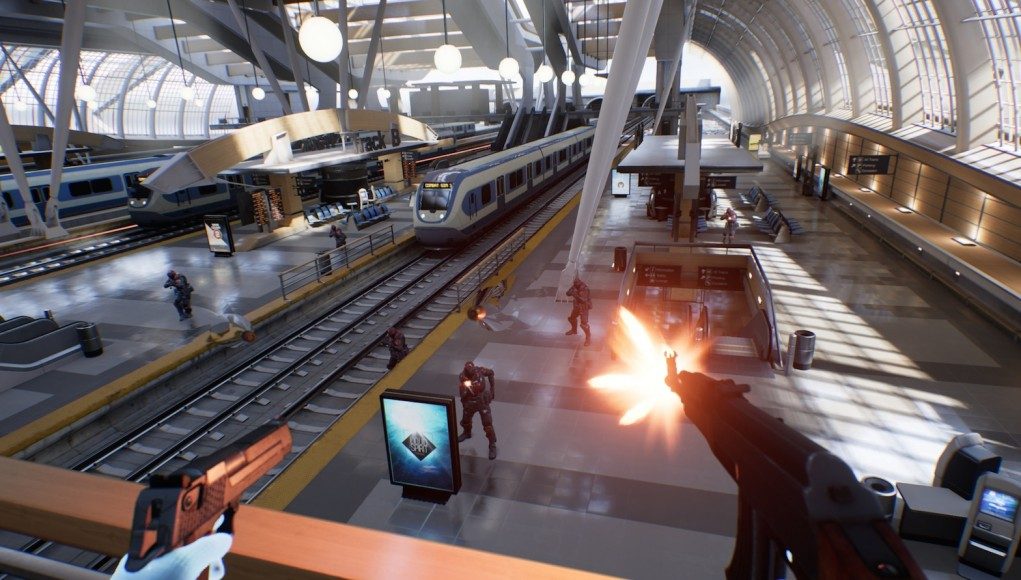 Ray Davis is the Studio Manager of Epic Games Seattle, and he talks about working on Bullet Train, which is Epic’s latest VR tech demo that uses the Oculus Touch controllers and debuted at the Oculus Connect 2 gathering. I had a chance to catch up with Ray at the Seattle VR conference where he told me about the iterative design process behind Bullet Train, the evolution of the teleportation VR locomotion approach, and how they discovered the innovative bullet grab and throwing game mechanic.
Ray Davis is the Studio Manager of Epic Games Seattle, and he talks about working on Bullet Train, which is Epic’s latest VR tech demo that uses the Oculus Touch controllers and debuted at the Oculus Connect 2 gathering. I had a chance to catch up with Ray at the Seattle VR conference where he told me about the iterative design process behind Bullet Train, the evolution of the teleportation VR locomotion approach, and how they discovered the innovative bullet grab and throwing game mechanic.
LISTEN TO THE VOICES OF VR PODCAST
Audio PlayerRay Davis talks about some of the goals and motivations behind Bullet Train. Epic wanted to create an immersive VR experience that was interactive and dynamic designed for anyone to go through regardless of what their level of gaming experience might be. Lead VR engineer Nick Whiting and Creative Director Nick Donaldson collaborated on creating Bullet Train, and they wanted to explore what it means to have hand presence within a VR experience.
Ray says that there’s an art to constructing a competitive death match environment in terms of the player flows and different pickups that encourage different pathways throughout the environment. It’s not just a matter of teleporting from location to location, and Nick Donaldson took a lot of that into consideration when creating Bullet Train.
Bullet Train has definitely been the most comfortable first-person shooter experience that I’ve had in VR so far. This level of comfort is largely thanks to their teleportation mechanic in order to move between different way points that are set on a subway train and out into the station. There’s a ghosting trail that you can see after you teleport that can help you orient you to your new location. Ray says that they thought a lot about ways to design the experience so that you could have enough visual cues to maintain your orientation as you teleported between the various waypoints.
Ray says that game design process at Epic Games has always been very organic and iterative. His advice is to just make a VR experience, and then see what people want to try to do in the experience, and then implement those things if it hasn’t been implemented yet. This is how they discovered their bullet grabbing and throwing game mechanic. They noticed that people kept trying to to catch them, and so they went ahead and just added that feature. He says that their ultimate goal is to create an intuitive experience such that people forget that they’re controlling a game, and that they can get into a flow where they’re reacting with their unconscious muscle memories.
Ray says that it’s ultimately a lot of fun to develop for virtual reality when you’re the target audience, because you’re the best expert in what you find fun and engaging. Especially when they could look to their favorite Hollywood action movies, and see what they could start to recreate within their VR experience. There are a still a number of design challenges in moving something like Bullet Train from a novel tech demo into a full-fledged game, and Ray didn’t mention any specific plans for what the future of Bullet Train might be. But it wouldn’t be surprising if they were continuing to refine and develop this concept after giving more than 500 demos over the last couple of months.
There’s also a lot of these experiments in VR where these ad hoc teams at Epic are able to dogfood the Unreal Engine. And so there is a lot of feedback and improvements that are made to the engine to make it more and more well-suited to create different virtual reality experiences. Ray says that part of the culture at Epic Games is to make things, and then try to give as much away of those innovations as possible.
Finally, Ray sees that VR and AR will have a convergence and eventually replace our screen-based interfaces in monitors, laptops, tablets, and phones. He sees that VR and AR will continue to unlock a lot of actual changes with how we gather and consumer information as well as how we connect with each other.
Become a Patron! Support The Voices of VR Podcast Patreon
Theme music: “Fatality” by Tigoolio







